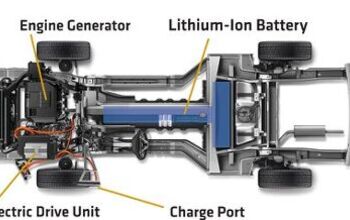Volt Birth Watch 101: Gas Engine Does NOT Recharge Batteries
Edmunds Inside Line reveals that GM has changed their propulsion plans for the plug-in electric – gas hybrid electric Volt. We were laboring under the impression– created by GM’s itself– that the Volt would complete its [theoretical] 40-mile all-electric range and then use its internal combustion engine to recharge the batteries on the fly. Nope. “A release from the day of the production prototype’s reveal reads, ‘a gasoline/E85-powered engine generator seamlessly provides electricity to power the Volt’s electric drive unit while simultaneously sustaining the charge of the battery.’ And by ‘sustaining’ GM says that it means only that no additional power is drained from the batteries.” Get it? If not… “Once a driver uses up his 40 or so miles of electric power, the 1.4-liter gas engine generates electricity to power the electric drive motor, but does not recharge the batteries. After the 40 or so miles, the battery becomes 400 pounds of uselessness, at least until the owner can plug the car into the electrical grid for a recharge. This means that regardless of how far one drives the Volt, the driver will only ever get up to 40 miles of electric-only range.”
More by Robert Farago


































Comments
Join the conversation
Now that I think about it, the Volt's main claim to fame might be as a source of battery packs suitable for the electric car conversion hobby.
The Edmunds article is aweful and misinformed. Here's how I explained GM's charge stratagy to a friend of mine, when he saw the original article and asked me about it: In fact, it's good that the gas engine does not recharge the batteries because then you would be using gasoline to charge them instead of grid power. The cost per kWh using the engine to recharge is much more than the cost per kWh using grid electricity. So, why would you want the engine to kick on to charge your batteries when you're only 10 miles from your house (where you can charge it for much less $$)? What they don't say is that the gas engine is sized so that, when acting as a generator, the car will still have full power to accelerate, climb hills, etc. I believe it can actually dip into the battery reserve for sudden bursts of power if needed. The batteries are never allowed to fully discharge anyway. The will only be discharged to 30%. That's the only way to make then survive for >100K miles. Unlike NiCd batteries, Li batteries don't like a full charge or a full discharge. So, the engine "maintains" battery levels at 30% of charge once you've driven 40 miles. It will still "charge" the batteries during regenerative breaking, etc and dip into that 30% for short bursts, it just won't waste any more gasoline than necessary to move the car around between plug in points. I think it's supposed to still get over 50 mpg when the gasoline engine is running as an alternator and the battery is discharged to the minimum level (30%). It may seem unconventional compared to a parallel hybrid (this is a SERIES hybrid), but will probably save the consumer the most money.